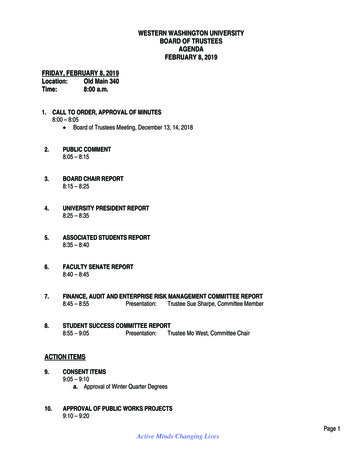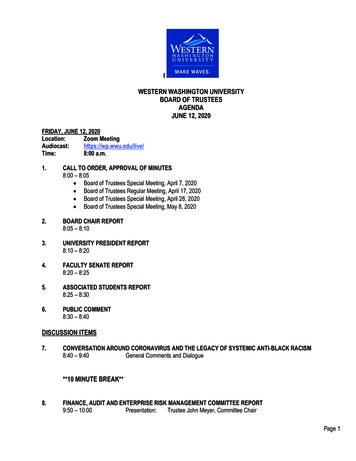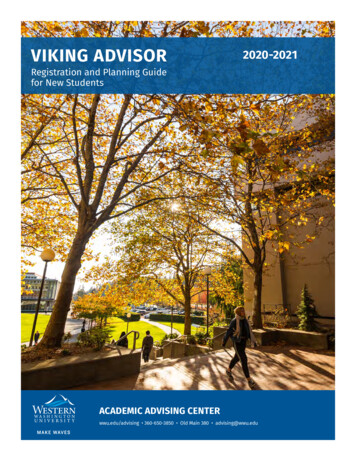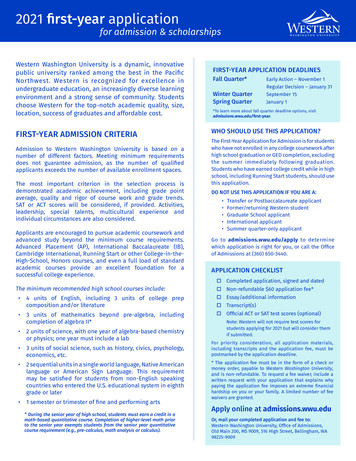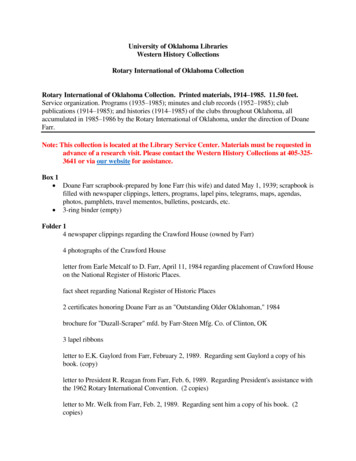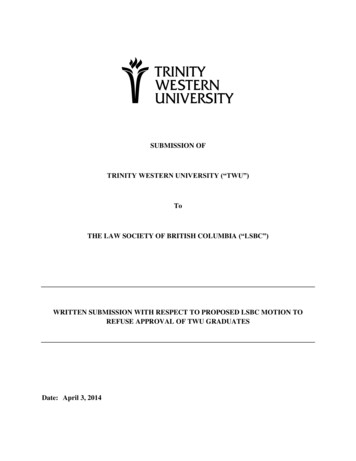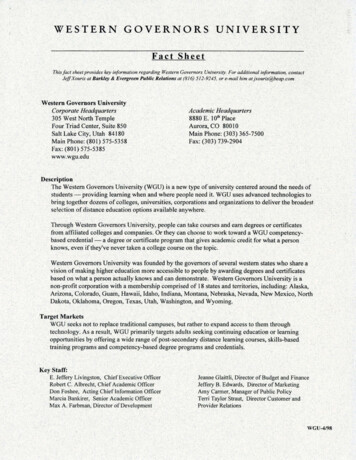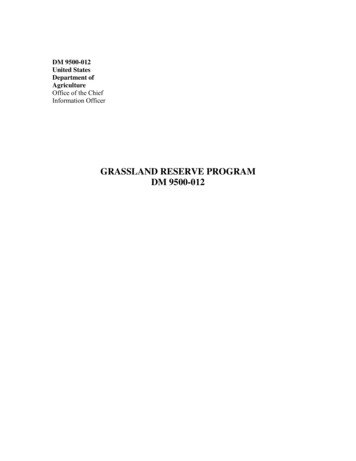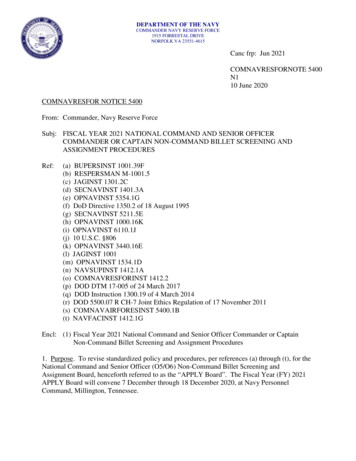
Transcription
weatherheadcollectionCase Western ReserveUniversity the Weatherhead School of Management semi-annual book one: perspective
What’s in a frame? You can frame a house, a painting, aproposition, a question, or a reply. You can simply change yourframe of reference, or change your entire frame of mind. Youcan frame things many different ways, and the WeatherheadSchool of Management challenges you to do just that.As we launch The Weatherhead Collection, the newest addition to our outreach efforts, we hope you gain a sense of the energy andexcitement about our unique approach to management education. From the first few pages, you will feel as if you are inside a worldclass exhibit. Precious white space, large images, vibrant splashes of color and, of course, our framed initiatives all pay homage toWeatherhead’s philosophy and location in University Circle, Cleveland’s arts & cultural district.Our years of research and dedication to Manage by Designing and to Sustainability and World Betterment are focal points that arehelping transform the face of management practices. The wealth of cultural institutions within walking distance of our front doorhas helped us foster educational and collaborative relationships – bringing artists, designers, healthcare professionals, theatricaldirectors, entrepreneurs, and management students together and challenging them to look at the business world differently.We have framed our initiatives for you here with the intent that after reading, you will look at business differently and see whyWeatherhead is a one-of-a-kind original.
Weatherhead by theNumbers7 Academic Departments71 Full-Time Faculty64 Full-Time Staff1,511 Students3Undergraduate Programs6 Masters Programs4Doctoral Programs16 Endowed Chaired Professors4 Editors of Academic Journals30 Undergraduate Business Program(U.S. News & World Report, 2008)#13#Undergraduate AccountancyProgram (Business Week, 2008)#3 Organizational BehaviorDepartment (Financial Times, 2008)In This ExhibitionFeature StoriesColumnsManage by Designing. 08Weatherhead in the News. 14From Cows and Cassava come Kilowatts. 18Faculty in the Field. 16The New MBA. 24Executive Education. 22Donor Focus. 28By Department. 30Alumni on the Move. 34What’s in a Name?Twenty-nine years ago, Case Western Reserve University’s Board of Trustees passed aresolution renaming our institution the Weatherhead School of Management to honor theWeatherhead family’s leadership in business and industry. The declaration followed a 3million gift, and so came the founding of the School as we know it today.Since then, Albert J. Weatherhead, III, chairman and CEO of Weatherhead Industries,has had continued involvement with Case Western Reserve that goes well beyond thenaming of our management school. He is an Honorary Trustee and Emeriti Trustee of theUniversity and has served on the Weatherhead Visiting Committee. Mr. Weatherheadalso has three endowments within the School of Management including the Celia J. &Albert J. Weatherhead, III Endowment Fund; the Albert J. Weatherhead, III Professor ofManagement; and the Weatherhead Fund for the School of Management.Through the generous support of the Weatherhead family, we have emerged as a topmanagement school both nationally and globally. Our innovative curriculum taught bythe very best faculty sets us apart from competitors because it equips future businessleaders with the tools to solve today’s tough issues through cutting-edge techniques inSustainability and World Betterment, and Manage by Designing.According to Dr. Richard Boland, co-creator of Manage by Designing and professor inthe Information Systems Department, “The world needs hearts and minds that can riseabove textbook ways of framing problems in order to invent inspiring alternatives thatare sustainable in the face of growing complexity, uncertainty, and risk. It needs mindsand hands that are capable of modeling and constructing true value creating products,services and organizations that are beyond our ability to imagine today. It needsgraduates of the Weatherhead School.”At the Weatherhead School of Management, we produce courageous young leaders whocan remake our future.
Februaryweatherhead collectionbook one: perspective fall 2008The Weatherhead Collection is published twiceyearly by the Office of External Relations for thealumni, students, friends, faculty, and staff ofthe Weatherhead School of Management, CaseWestern Reserve University.17-18 – Executive Education“Innovation by Design: Creating PowerfulCustomer Experiences and Solutions”19 – Executive Education“Using Power and Influence for Womenin Healthcare Leadership”Case Western Reserve UniversityWeatherhead School of Management10900 Euclid AvenueCleveland, Ohio 44106weatherhead.case.eduweatherhead collectionRebecca MurphyEditorMarla ZwinggiAssistant EditorEmily DrewContributing Writerpolkadotpeeps, ltd.DesignN. Mohan ReddyDean and Albert J. Weatherhead, III Professor of ManagementSonia WinnerAssociate Dean for External RelationsWe welcome your comments at weatherhead@case.edu.events& happeningsDecember2 – Weatherhead 100For 21 years, Weatherhead 100 hasserved as a prestigious ranking system,recognizing the region’s fastest growingcompanies and more than 2,000entrepreneurs. Join us at the black-tiegala to celebrate this year’s winners.5 – 35th Annual David A. BowersEconomic Forecast Luncheon2008 was filled with plenty of economicshockers. What will 2009 bring?Banking & Finance Senior Lecturer SamThomas delivers his predictions.5 – Last day of classes11 – Executive Education“Developing Resonant Leadership:A Day with Richard Boyatzis, Ph.D.”January6-13 – Alumni Events in India12 – Back to School21 – Executive Education“Executing Strategy for ExecutiveManagement with Sayan Chatterjee, Ph.D.”production notes20 – Dean’s WeekendOutstanding MBA candidates—personally invited by Dean Reddy—arrive on campus for a weekendpreview of all things Weatherhead.21 – Casino NightTry your luck at the Graduate BusinessStudent Association’s annual Casino Night.Or, if wagering isn’t in your cards, make adonation to the silent auction or raffle.27 – Darwin, Democracy andOrganizationsAs part of the 2008-2009 Year ofDarwin and Evolution series at Case,Weatherhead is sponsoring a lectureby Hayagreeva Rao, an alumnus ofWeatherhead (Ph.D. ‘89) and the AthollMcBean Professor of OrganizationalBehavior and Human Resources fromStanford University’s Graduate Schoolof Business.March10 – Executive Education“Leadership for Quality Improvement inHealthcare Organizations”11 – Executive Education“Reducing Waste and ImprovingPatient Safety”12 – Executive Education“Engaging People’s Passion:Leadership through Vision in HealthcareOrganizations with Diana Bilimoria, Ph.D.”To access the complete Weatherhead event calendar visitweatherhead.case.edu/about/events
Take a look around your office. Amidstthe piles, stacked files, flowcharts,and business hierarchy diagrams isdesign. Every form, policy, process, andinteraction in your organization has beendesigned. Whether it was with intention orby accident, a human shaped how thesethings look, feel, change, and interact.Those choices were approved eitherexplicitly or implicitly and have come to beaccepted parts of the world.Managers design. There’s no questionabout it. But how can managers excel atdesign and what tools do they need?How will managers consciouslyexecute design responsibilitiesand how can they skillfullyuse design to achieve theirorganization’s goals?Over the past decade, we havebeen studying great designersand their organizations tolearn about developing greatmanagers. Our timing turns outto be fortuitous for at least tworeasons. One has to do with thenature of design. Design is most oftena response to complex problemsthat cannot be solved with a quick fix.Dealing with the bailout of the financialsector, marketing a reformulatedproduct to reduce costs, and respondingto customer complaints are just a fewexamples of issues that require more thana simple solution. As the world of modernmanagement faces more of these types ofproblems, it calls for more attention to howwe manage by designing.by fred collopySecondly, the world is gaining interest inthe relationship between managing anddesigning. Business Week has caughton, dedicating special sections overthe past two years and preparinga third. The Harvard BusinessReview has published several articlesincluding one in which bestselling authorDaniel Pink speculates that the “MFA maybe the new MBA.” CEOs of companiesincluding IDEO and Procter & Gamblehave written books about how designis permeating organizational culturesand the practice of management. Nowat Weatherhead, we are placing moreemphasis on designing in our curriculum.According to Ralph Caplan, author of ByDesign, “Design is not everything, but itsomehow gets into almost everything.”Design is the power to conceive, plan,and develop products that serve humanbeings, allowing them to accomplish theirindividual and collective goals. Productsin a broad sense include everything fromcommunications to services, experiences,and even organizational structures andprocedures. Essentially, design has movedfrom a focus on “posters and toasters” tobroader areas, just as management hasbeen called on to deal with less regularand more complex situations.What talents do designers have that canbe taught to managers? The results of ourinvestigations to date suggest that theanswers include a new attitude, a new wayof thinking, and a new set of skills.Decision Attitude versus Design AttitudeBefore contrasting the two, it is importantto point out that doing so is not to suggestthat one should replace the other, but thatboth are essential to great management.today’s world is very different from the1950s when these ideas gained traction.A design attitude is that of a generalist.While most designers have specialty skills,the attitude with which they approach anew assignment involves viewing it as anopportunity to learn new things and sweepin an array of influences. This is donein part as an acknowledgement of ourrapidly changing world and a belief thatthey can do better than what has alreadybeen done.A decision attitude makes the assumptionthat the difficult task comes in choosingamong alternatives. A design attitudeassumes that the hard work comes increating even better alternatives. Oncegood choices are developed, it isrelatively easy to select the one that bestsuits the situation.A decision attitude sees constraints asproblems to be wished away. A designattitude embraces constraints, seeingin them clues to the situation’s mostexciting possibilities.It goes without saying that designis concerned with the betterment ofsituations. As a consequence, it is notuncommon to witness a designer’sskepticism toward default solutions.Instead of relying on the status quo, agreat designer develops a solutionwhile simultaneously solving additionalproblems that were unidentified previously.A decision attitude contributes tomanagement efficiency and effectivenessin stable well-defined situations. Majoradvances have occurred in the toolsused for decision analysis and supportto establish a more mathematical andscientific basis for management, butweatherhead collection CASE WESTERN RESERVE UNIVERSITY WEATHERHEAD SCHOOL OF MANAGEMENT SEMI-ANNUAL book one: perspective
Design Thinking is about dealing with complexity, messiness,heuristics, and collaboration. A problem that isn’t complexdoesn’t require design. The challenge of making somethingcheaper, or smaller, or more elegant than its current state canbe fun and productive. Successfully dealing with constraintsis a source of pride and prestige among designers. With thiskind of complexity becoming more common in organizations,designers maintain that their skills are more applicable thanever. Given the unstructured nature of the problems to whichdesign is applied, it comes as no surprise that design thinkingrelies upon heuristics rather than the application of rules or algorithmic computations.Heuristics may be quite personal, having evolvedfrom the experience of thedesigner. This personalcharacter of design is oftenpresented as one of thestrengths of design thinking. It suggests that theoutcome can depend significantly on who doesthe designing.
While managers have traditionally assumed permanent positions with an ongoing set of responsibilities, design thinking is seen as inherently collaborative and ad hoc. Designers live in a world of projects. They function as members ofteams often only for the duration of one project and then areoff to work with others on something else.Twenty-five years ago, Beth Fitz Gibbonwas a writer for a top ad agency inNew York City. “Back then businessorganization used to be silos of finance,marketing, sales, and hierarchy. Thisdoesn’t happen anymore,” she said.“Alliances and partnerships are key now.Things are messy and complicated, butnot in a negative sense. It just meansthat you have to assemble a differentkind of team.”Fitz Gibbon is now president of amanagement consulting firm specializingin product development and in herthird year of the Executive Doctor ofManagement program at Weatherhead.She has used Manage by Designingthroughout her entire career, althoughshe was not always conscious of it. “Inever thought about it in the first place, Ijust did it,” she said. Now she’s studyingit formally in the classroom. “I alwaysfind it best to think of a problem as apossibility rather than a limitation. Starttalking as a group instead of throwingtogether a PowerPoint.”Design SkillsOne highly visible feature of design thatwill enable managers to take on complexproblems more effectively is the use ofmodels and sketches for thinking andcollaborating. In management, more oftenthan not, only one model or sketch isbrought to bear on a particular problem.This is striking because models play adifferent role in the design world. Anarchitect may create hundreds of modelsfor a building, with dozens related to justone specific element.Reframing is another skill that designersbring to the table. In the 1950s, manypeople were concerned with improvingthe speed of cargo ships. But the mostdramatic change in shipping in thatcentury resulted from entrepreneurMalcolm McLean’s view of it as a problemin loading and unloading. With theinvention of container shipping, timein port shrunk from three weeks to 18hours. Increasingly, problems defy theboundaries along which businessesorganize themselves—marketing,production, human resources, finance,and accounting. Instead, they come asmessy tangled webs.Other skills designers rely upon includeabduction and intuition, observationand ethnography, visual and integrativethinking, and teamwork. Many of theseare embedded in the skill set we teachto MBAs.When I presented the method of adesign critique—moving systematicallyfrom a description through analysis andthen interpretation before arriving at ajudgment—one of my students, JekkiKim, observed “Wouldn’t things gomuch more smoothly if we adopted thisprocess in managing generally?” In NobelPrize laureate Herbert Simon’s terms, allmanagers are engaged in the sciencesof the artificial and designing is central tothat, so we might as well get good at it.Design almost always includes anelement of discovery. If we already knowhow to solve the problem at hand andneed only to apply the solution, it israrely described as designing. Of course,conditions change, so what was once ano-brainer can become a design puzzle.Helping managers know when to put ona design attitude, call on design thinking,and employ design skills are amongthe most challenging issues facingmanagement education and it’s what weteach at Weatherhead.To learn more visit design.case.eduweatherhead collection CASE WESTERN RESERVE UNIVERSITY WEATHERHEAD SCHOOL OF MANAGEMENT SEMI-ANNUAL book one: perspectiveDecision Attitude versus Design AttitudeDesign ThinkingDesign Skills
Reaching New HeightsAs Weatherhead Evolves,So Does Our HomeAlbert J. Weatherhead, III’sPower of Adversityprogram improved three spots in the U.S.Spatial improvements are complete at theAlbert J. Weatherhead, III, chairmanNews & World Report “America’s BestPeter B. Lewis Building to create moreand CEO of Weatherhead Industries andColleges” 2009 rankings. The program atclassroom area and an improved loungebenefactor of our School continues toWeatherhead ranks 30th nationally, up fromfor students, faculty, staff, and visitors. Theadd to his distinguished 60-year career33rd a year ago.new classroom, now room 258, combinesby releasing a new book, The Power ofa former Ph.D. cubicle area and twoAdversity: Tough Times Can Make YouWeatherhead made a big jump of 11 spotssmaller meeting rooms into a brand newStronger, Wiser, and Better. The story detailsto number 41 in Business Week’s rankingsclassroom that stretches 1,293 square feethis successes and struggles both personallyof the best undergraduate business schoolsand accommodates up to 120 people. Theand professionally. It also offers advice forfor 2008. In the category of academic quality,room has built-in audio visual capabilitiesovercoming obstacles and learning how toand is intended to be used for specializedlook at problems as opportunities.Weatherhead’s overall undergraduateWeatherhead ranked 12th overall andreceived an A-plus grade for teaching quality.Anonymous BenefactorCollaboration for theGreater GoodWeatherhead received a 2.44 million giftB. Charles Ames Says “Yes”Welcoming the World toClevelandSuccessful businessman and esteemedWeatherhead’s Accountancy Departmentfrom an anonymous benefactor that will assistCase Western Reserve University, led bybenefactor, B. Charles Ames says he only likesOne thousand global leaders inwas declared 13th in the nation by Businesson-going work in the initiative Manage byWeatherhead’s Center for Business as anquestions that can be answered with a “yes, nobusiness, management, academics, andWeek’s “Undergraduate Specialty ProgramDesigning. The gift supports collaborationAgent of World Benefit, marked Earth Dayor a number”. Mr. Ames has remained true to hissustainability issues will assemble at CaseRankings.” News of the program’s rank hasbetween the worlds of design and2008 by officially signing on as a member ofmantra by saying “yes” to Weatherhead with aWestern Reserve University June 2 – 5,helped Weatherhead attract prospectivemanagement and enriches students’ ability tothe United Nations Global Compact. 1 million commitment for the implementation of2009, for the second Global Forum forstudents and maintain the strength of itscreate and lead innovation across business,the B. Charles Ames Business Plan CompetitionBusiness as an Agent of World Benefitcurrent class of Accounting majors.the arts, and the nonprofit sector.and Distinguished Speaker Series in Corporate(BAWB). The United Nations GlobalGovernance and Creating Shareholder Value.Compact and the Academy of ManagementThe Global Compact is an internationalinitiative to promote responsible corporateThe Financial Times ranked Weatherhead’sWeatherhead is among a select groupcitizenship. With more than 4,000Department of Organizational Behaviorof management schools with a focusworldwide corporat
11 – Executive Education “Developing resonant Leadership: a Day with richard Boyatzis, Ph.D.” January 6-13 – Alumni Events in India 12 – Back to School 21 – Executive Education “executing strategy fo

